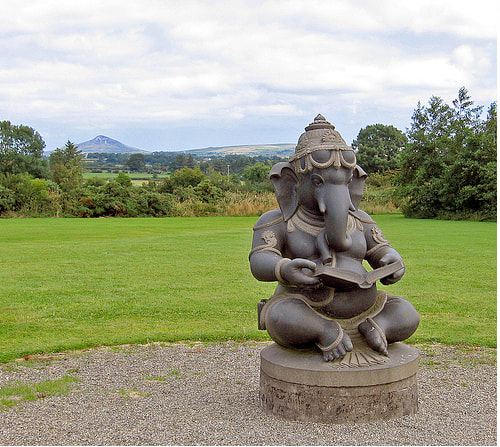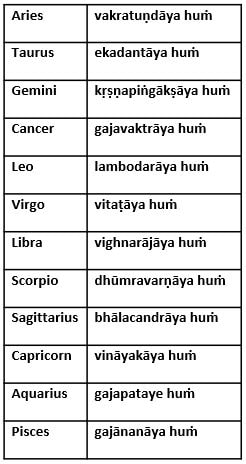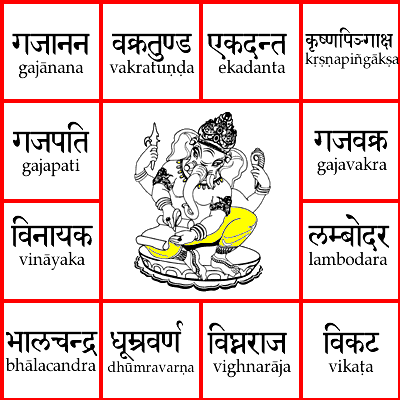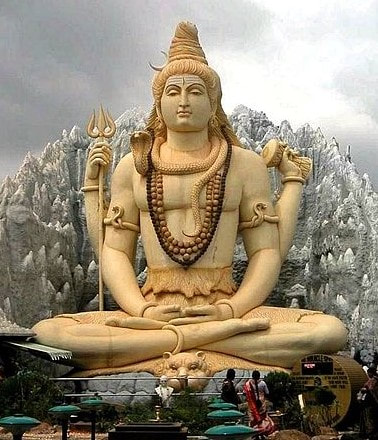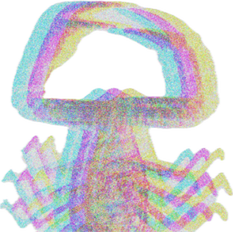Mantras to overcome fear and increase clarity
Om Gaṃ Gaṇapataye Namaḥ
A useful mantra to begin with is one for Gaṇeśa, the lord of 'Vedic' astrology and the 'remover of obstacles'. The above mantra is a simple place to begin mantra recitation. Be aware, however, there are some Sanskrit rules to adhere to for proper pronunciation, and a controversy around how the ending should be sounded.
When you see an 'ā' sound it is more like the English a, as in the word 'apple', whereas when you see an 'a' sound without a dash over it, it is sounded more like 'uh', or the beginning sound in the word 'orange'. So, think apples and oranges!
This is fine when you only have one in a word, but gets a bit tricky when there are several in one word, as you will see in the above mantra. A good practice is to right down these sounds as 'aaa' for ā and 'uh' for a.
There's a rule when the seed mantra for Gaṇeśa, GAṂ is followed with a 'ga' sound. Instead of sounding GAṂ with an 'm' sound to the lips, the 'm' sound is made at the back of the throat and ends up sounding like 'gan' or 'gong'. This is why you often see this mantra written as Om Gong Gaṇapataye Namaḥ or Om Gan Gaṇapataye Namaḥ.
The word Namaḥ brings up a controversy surrounding the visarga sound at the end of the word. Although many Sanskrit scholars and teachers say an echo of the preceding vowel should be sounded, which would mean it is sounded as namaha, others say it should not be sounded, and that the visarga merely represents a release of the breath.
No such controversy exits if the word namaḥ were found in the middle of a mantra, such as Om Namaḥ Śivāya, where everyone agrees that the extra sound is left out.
When you see an 'ā' sound it is more like the English a, as in the word 'apple', whereas when you see an 'a' sound without a dash over it, it is sounded more like 'uh', or the beginning sound in the word 'orange'. So, think apples and oranges!
This is fine when you only have one in a word, but gets a bit tricky when there are several in one word, as you will see in the above mantra. A good practice is to right down these sounds as 'aaa' for ā and 'uh' for a.
There's a rule when the seed mantra for Gaṇeśa, GAṂ is followed with a 'ga' sound. Instead of sounding GAṂ with an 'm' sound to the lips, the 'm' sound is made at the back of the throat and ends up sounding like 'gan' or 'gong'. This is why you often see this mantra written as Om Gong Gaṇapataye Namaḥ or Om Gan Gaṇapataye Namaḥ.
The word Namaḥ brings up a controversy surrounding the visarga sound at the end of the word. Although many Sanskrit scholars and teachers say an echo of the preceding vowel should be sounded, which would mean it is sounded as namaha, others say it should not be sounded, and that the visarga merely represents a release of the breath.
No such controversy exits if the word namaḥ were found in the middle of a mantra, such as Om Namaḥ Śivāya, where everyone agrees that the extra sound is left out.
Gaṇeśa in your Birth chart
To make a Gaṇeśa mantra more specific to your needs, you could chant a form of Gaṇeśa based on the position of the south node (Ketu) in your horoscope, as Ketu is represented by Gaṇeśa and helps us to remove the obstacles of the north node, Rāhu.
The following are the mantras for each form of Gaṇeśa (Ketu) in each zodiac sign, where the mantra huṁ (pronoucned hoom) is added to each form:
The following are the mantras for each form of Gaṇeśa (Ketu) in each zodiac sign, where the mantra huṁ (pronoucned hoom) is added to each form:
There is another, even more specific, way to use the above mantras.
Find the planet that rules the 11th sign of your birth chart if you have a movable rising sign, i.e. Aries, Cancer, Libra or Capricorn; the 9th sign ruling planet if you have a fixed sign rising, i.e. Taurus, Leo, Scorpio or Aquarius; or the 7th sign ruling planet if you have a dual sign rising, i.e. Gemini, Virgo, Sagittarius or Pisces.
Chant the mantra for the sign opposite this planet's placement in your birth chart.
Find the planet that rules the 11th sign of your birth chart if you have a movable rising sign, i.e. Aries, Cancer, Libra or Capricorn; the 9th sign ruling planet if you have a fixed sign rising, i.e. Taurus, Leo, Scorpio or Aquarius; or the 7th sign ruling planet if you have a dual sign rising, i.e. Gemini, Virgo, Sagittarius or Pisces.
Chant the mantra for the sign opposite this planet's placement in your birth chart.
Mrtyuñjaya mantra
Mrtyuñjaya mantra is a very special mantra when it comes to allaying fears. It is chanted for Śiva, 'the destroyer', the One who destroys our fears. This mantra is a powerful tool to build strength on every level of our being, and can be used to overcome illness, and even the fear of death. Chanting it every morning and evening for 40 days is said to bring healing, and a healer, if needed.
As you will read in the translation the sounds of the mantra directly correspond to the meaning of the words being chanted. So, for example, the Sanskrit word yajāmahe , when chanted correctly, captivates the meaning 'we sing thy praise' very well. The Sanskrit word bandhanān really captures the sense of being 'bound down'.
ॐ त्र्यं॑बकं यजामहे सु॒गन्धिं॑ पुष्टि॒वर्ध॑नम् ।
उ॒र्वा॒रु॒कमि॑व॒ बन्ध॑नान् मृ॒त्योर् मु॑क्षीय॒ माऽमृता॑त् ।
Oṃ tryaṃbakaṃ yajāmahe sugandhiṃ puṣṭivardhanam
urvārukamiva bandhanān mṛtyor mukṣīya mā'mṛtāt ||
Mrtyuñjaya mantra is a very special mantra when it comes to allaying fears. It is chanted for Śiva, 'the destroyer', the One who destroys our fears. This mantra is a powerful tool to build strength on every level of our being, and can be used to overcome illness, and even the fear of death. Chanting it every morning and evening for 40 days is said to bring healing, and a healer, if needed.
As you will read in the translation the sounds of the mantra directly correspond to the meaning of the words being chanted. So, for example, the Sanskrit word yajāmahe , when chanted correctly, captivates the meaning 'we sing thy praise' very well. The Sanskrit word bandhanān really captures the sense of being 'bound down'.
ॐ त्र्यं॑बकं यजामहे सु॒गन्धिं॑ पुष्टि॒वर्ध॑नम् ।
उ॒र्वा॒रु॒कमि॑व॒ बन्ध॑नान् मृ॒त्योर् मु॑क्षीय॒ माऽमृता॑त् ।
Oṃ tryaṃbakaṃ yajāmahe sugandhiṃ puṣṭivardhanam
urvārukamiva bandhanān mṛtyor mukṣīya mā'mṛtāt ||
|
|
Translation from 'Vedic Remedies in Astrology' by Pt. Sanjay Rath. Used by kind permission.
"O! Three-eyed Lord Shiva (three luminous eyes represent the Sun, Moon and Holy fire) we worship Thee; Thy name and fame spreads like sweet fragrance as Thou art the savior of all beings. I am under the bondage of dreadful diseases (of the mind, body and soul) and pray that Thou shalt deliver us from (all evils including) death (for the sake of immortality) by granting us some life rejuvenating nectar".
"OM is not spelt out in the Rig Veda, but has to be added to the beginning of all Mantras as given in an earlier Mantra of the Rig Veda addressed to Ganapati (Ganesh).
TRYAMBAKKAM refers to the Three eyes of Lord Shiva. ‘Trya’ means ‘Three’ and ‘Ambakam’ means eyes. These three eyes of sources of enlightenment are the Trimurti or three primary deities, namely Brahma, Vishnu and Shiva and the three ‘AMBA’ (also meaning Mother or Shakti are Saraswati, Lakshmi and Gouri. Thus in this word, we are referring to God as Omniscient (Brahma), Omnipresent (Vishnu) and Omnipotent (Shiva). This is the wisdom of Vashistha Maharishi and is referred to as Sri Dattatreya having three heads of Brahma, Vishnu and Shiva.
YAJAMAHE means, ‘We sing thy praise’.
SUGANDHIM refers to His fragrance (of knowledge, presence and strength i.e. three aspects) as being the best and always spreading around. Fragrance refers to the joy that we get on knowing, seeing or feeling His virtuous deeds.
PUSTIVARDHANAM: Pooshan refers to Him as the sustainer of this world and in this manner; He is the Father (Pater) of all. Pooshan is also the inner impeller of all knowledge and is thus, Savitur or the Sun and also symbolizes Brahma the Omniscient Creator. In this manner He is also the Father (Genitor) of all.
URVAAROKAMEVA: ‘URVA’ means ‘VISHAL’ or big and powerful or deadly.
‘AAROOKAM’ means ‘Disease. Thus, URVAOOKA means deadly and overpowering diseases. (The CUCUMBER interpretation given in various places is also correct for the word URVAROOKAM, but not apt for this mantra). The diseases are also of three kinds caused by the influence (in the negative) of the three Gunas and are ignorance (Avidya etc,), falsehood (Asat etc, as even though Vishnu is everywhere, we fail to perceive Him and are guided by our sight and other senses) and weaknesses (Shadripu etc. a constraint of this physical body and Shiva is all powerful).
BANDANAAN means bound down. Thus read with URVAROOKAMEVA, it means ‘I am bound down by deadly and overpowering diseases (of the body, mind & soul)’.
MRITYORMOOKSHEYA means to deliver us from death (both premature death in this physical world and from the never ending cycle of deaths due to re-birth) for the sake of Mokshya (Nirvana or final emancipation from re-birth).
MAAMRITAAT means ‘please give me some Amrita (life rejuvenating nectar). Read with the previous word, it means that we are praying for some ‘Amrita’ or get out of the death inflicting diseases as well as the cycle of re-birth".
Rath, S. (2000) Vedic Remedies in Astrology, New Delhi, India: Sagar Publications.
Translation from 'Vedic Remedies in Astrology' by Pt. Sanjay Rath. Used by kind permission.
"O! Three-eyed Lord Shiva (three luminous eyes represent the Sun, Moon and Holy fire) we worship Thee; Thy name and fame spreads like sweet fragrance as Thou art the savior of all beings. I am under the bondage of dreadful diseases (of the mind, body and soul) and pray that Thou shalt deliver us from (all evils including) death (for the sake of immortality) by granting us some life rejuvenating nectar".
"OM is not spelt out in the Rig Veda, but has to be added to the beginning of all Mantras as given in an earlier Mantra of the Rig Veda addressed to Ganapati (Ganesh).
TRYAMBAKKAM refers to the Three eyes of Lord Shiva. ‘Trya’ means ‘Three’ and ‘Ambakam’ means eyes. These three eyes of sources of enlightenment are the Trimurti or three primary deities, namely Brahma, Vishnu and Shiva and the three ‘AMBA’ (also meaning Mother or Shakti are Saraswati, Lakshmi and Gouri. Thus in this word, we are referring to God as Omniscient (Brahma), Omnipresent (Vishnu) and Omnipotent (Shiva). This is the wisdom of Vashistha Maharishi and is referred to as Sri Dattatreya having three heads of Brahma, Vishnu and Shiva.
YAJAMAHE means, ‘We sing thy praise’.
SUGANDHIM refers to His fragrance (of knowledge, presence and strength i.e. three aspects) as being the best and always spreading around. Fragrance refers to the joy that we get on knowing, seeing or feeling His virtuous deeds.
PUSTIVARDHANAM: Pooshan refers to Him as the sustainer of this world and in this manner; He is the Father (Pater) of all. Pooshan is also the inner impeller of all knowledge and is thus, Savitur or the Sun and also symbolizes Brahma the Omniscient Creator. In this manner He is also the Father (Genitor) of all.
URVAAROKAMEVA: ‘URVA’ means ‘VISHAL’ or big and powerful or deadly.
‘AAROOKAM’ means ‘Disease. Thus, URVAOOKA means deadly and overpowering diseases. (The CUCUMBER interpretation given in various places is also correct for the word URVAROOKAM, but not apt for this mantra). The diseases are also of three kinds caused by the influence (in the negative) of the three Gunas and are ignorance (Avidya etc,), falsehood (Asat etc, as even though Vishnu is everywhere, we fail to perceive Him and are guided by our sight and other senses) and weaknesses (Shadripu etc. a constraint of this physical body and Shiva is all powerful).
BANDANAAN means bound down. Thus read with URVAROOKAMEVA, it means ‘I am bound down by deadly and overpowering diseases (of the body, mind & soul)’.
MRITYORMOOKSHEYA means to deliver us from death (both premature death in this physical world and from the never ending cycle of deaths due to re-birth) for the sake of Mokshya (Nirvana or final emancipation from re-birth).
MAAMRITAAT means ‘please give me some Amrita (life rejuvenating nectar). Read with the previous word, it means that we are praying for some ‘Amrita’ or get out of the death inflicting diseases as well as the cycle of re-birth".
Rath, S. (2000) Vedic Remedies in Astrology, New Delhi, India: Sagar Publications.
Sāvitrī Gāyatrī
The Sāvitrī Gāyatrī is the oldest known mantra in continuous use, taken from Ṛg Veda 3.62.10, c. which is said to date around 1200 BCE, or older, according to Sanskrit scholar Christopher 'Hareesh' Wallis. The mantra contains 3 lines of 8 syllables each, ideally chanted with one out breath. OM̐ bhūr bhuvaḥ svaḥ is prefaced to the 3 lines found in the Ṛg Veda.
[ॐ भूर्भुवः स्वः] तत्सवितुर्वरेण्यं, भर्गो देवस्य धीमहि, धियो यो नः प्रचोदयात् ।
[OM̐ bhūr bhuvaḥ svaḥ] tat savitur varēṇyaṁ, bhargo devasya dhīmahi, dhiyo yo naf pracodayāt |
Translation by Christopher Wallis (hareesh.org):
"Om. Earth. Atmosphere. Heaven. May we focus our awareness on the alluring radiance of the rising and setting sun, the Vivifier; may He inspire our thoughts and meditations."
Savitur is the Sun god, particularly the rising Sun which rules over the lunar mansion, Hasta (meaning 'hand'), found entirely within sidereal Virgo. This mantra is ideally recited during sunrise, facing east, pouring water into one's hand and onto the Earth, as one greets the new day and the illumination the Sun provides. Traditionally, it was also recited at noon and sunset.
This mantra brings clarity. It illuminates the mind, just as the rising Sun brings light and awareness, dispelling doubts.
[ॐ भूर्भुवः स्वः] तत्सवितुर्वरेण्यं, भर्गो देवस्य धीमहि, धियो यो नः प्रचोदयात् ।
[OM̐ bhūr bhuvaḥ svaḥ] tat savitur varēṇyaṁ, bhargo devasya dhīmahi, dhiyo yo naf pracodayāt |
Translation by Christopher Wallis (hareesh.org):
"Om. Earth. Atmosphere. Heaven. May we focus our awareness on the alluring radiance of the rising and setting sun, the Vivifier; may He inspire our thoughts and meditations."
Savitur is the Sun god, particularly the rising Sun which rules over the lunar mansion, Hasta (meaning 'hand'), found entirely within sidereal Virgo. This mantra is ideally recited during sunrise, facing east, pouring water into one's hand and onto the Earth, as one greets the new day and the illumination the Sun provides. Traditionally, it was also recited at noon and sunset.
This mantra brings clarity. It illuminates the mind, just as the rising Sun brings light and awareness, dispelling doubts.
